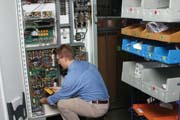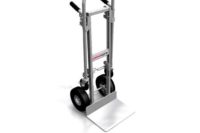
1. Reducing: Lower System Inefficiencies and Make Maintenance Preventative, Not Reactive
A temptation that companies often succumb to in tight economic times is skimping on equipment maintenance and overhauls. However, delaying maintenance can result in reduced equipment lifespan, more emergency repair-related downtime, and replacement costs for non-repairable components.
One effective way of keeping maintenance on track while reducing costs is to move from a reactive to a predictive maintenance cycle.
Predictive maintenance helps companies get ahead of the repair curve for parts and equipment by helping pre-determine when equipment failures will occur. Utilizing audit programs in combination with predictive and preventative maintenance software, companies can establish baseline failure rates over time and implement corrective action prior to failure.
A foremost concern for many enterprises is how to squeeze the best performance out of existing material handling systems and equipment without significantly increasing wear and tear or maintenance costs. One of the most effective yet least-used tools to determine how well systems are functioning is a performance audit. Is the equipment working properly or does it need fine-tuning? How well is the system performing overall? Does it still fit the user's needs? How well are the system operators fulfilling their duties? Is extra training warranted?
A thorough performance audit can answer each of these questions quickly and is an invaluable benchmarking tool. By highlighting system strengths and weaknesses, an in-depth assessment can uncover hidden productivity drains that can then be addressed. Material handling areas subject to evaluation may include picking, queuing, staging, sorting rates, equipment and system functionality, and operator effectiveness. A complete audit should include both an operational and functional analysis, with a final report outlining recommended corrections such as maintenance needs, capacity optimizations, and additional operator training.
By adopting a proactive approach to finding and correcting system and equipment inefficiencies, companies can realize true cost-savings in the form of higher productivity rates and optimized system performance. Employing a predictive maintenance program also offers a reliable, cost-effective method for preserving capital and reducing expenditures.

Many operations today have older-model material handling equipment and systems that cannot provide the same productivity levels found in newer models and thus, are faced with the possibility of a large capital outlay for the purchase of expensive new equipment in order to keep up with increased demand. There is however, a solution that not only helps to keep replacement costs to a minimum, but can also result in efficiency improvements of 15 to 20 percent or more-retrofitting.
Retrofitting and repurposing equipment rather than replacing it can result in substantial savings to the bottom line; the complete overhaul and retrofitting of older equipment can often be done for less than 60% of the cost of a new machine. The financial savings extend beyond just replacement costs: equipment retrofitting and modernization offers renewed operational life with minimal expenses, increased production cycle times, reduced maintenance and operating expenses, and improved reliability. In addition, retrofitting can help control costs by bringing equipment safety standards up to par with current federal and state OSHA safety regulations, reduce work-related accidents and injuries, and help to lower insurance premiums, including workers compensation.
Retrofitting also enables companies to modernize, adjust, and adapt their existing equipment to meet new production conditions. By adding new technology, upgraded parts and equipment, and capacity optimizations, users can often extend their systems beyond the originally designed capacity. Many equipment suppliers have designed new product technologies to be backwards compatible with older models, enabling these advances to integrate seamlessly with existing equipment.
Vendors can offer proposals for retrofitting that usually include several solutions models to select from, providing maximum flexibility. Another cost-cutting option allows the user to choose whether to have Alvey Systems trained service professionals perform any needed retrofits or to have company personnel perform them in-house using detailed visual step-by-step instructions. An equipment retrofit might typically include the introduction and integration of adapted control systems, extended access to real-time operational data, the addition of volume and weight data for checking and invoicing, advanced induction and sorting functions, and the ability to sort of non machine-sortable items, and the installation of upgraded parts. A retrofit or overhaul also provides the opportunity for parts standardization, reducing the cost of and increasing the availability of replacement parts.
3. Recycling: Remanufacturing Saves Money, Preserves Resources
Maximizing the return on investment in capital machinery is important to every enterprise. Many times, however, a company's existing system and machines can't handle changes in production requirements, such as increased demand, new products, different pattern requirements, or changes in speeds. It's at this point that most operations begin thinking about new equipment expenditures.
When buying new capital equipment, the bulk of the final purchase price is often the aggregate value-added costs such as raw and processed materials needed to manufacture the equipment, labor and energy for assembly, and the logistics expense of transporting and installing the finished equipment. Purchasing a new piece of equipment dictates that the enterprise undertakes all of these expenses with the hope that they will be recouped over the product lifecycle. With remanufacturing however, a large portion of this overhead is significantly reduced, as much of the value-added equity of the original product is retained. It takes far less resources, labor, and energy in order to dismantle, clean, replace broken and worn parts, refinish, and reassemble equipment than to buy new machinery. Often, the remanufactured equipment will carry the same warranty as new equipment, extending not only the lifecycle of the product but the value, as well.

Beyond significant the financial and potential tax benefit to the corporate bottom line, the purchase of remanufactured equipment offers positives to the environment, as well. Companies choosing to purchase remanufactured products rather than new products help keep valuable raw materials from entering the waste disposal stream, reduce costs associated with material disposal, and lower the volume of industrial solid waste bound for limited landfill space.
Remanufacturing offers solid benefits to the enterprise in terms of lower capital equipment costs, renewed product lifecycles, and the potential for significant tax-related gains. It also helps the economy and the environment at large, offering companies the opportunity to be good corporate stewards with no additional costs.
